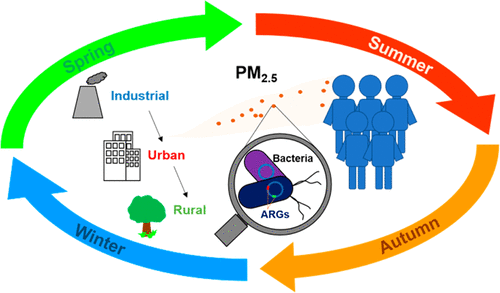当前位置:
X-MOL 学术
›
Environ. Sci. Technol. Lett.
›
论文详情
Our official English website, www.x-mol.net, welcomes your
feedback! (Note: you will need to create a separate account there.)
Seasonal Disparities in Airborne Bacteria and Associated Antibiotic Resistance Genes in PM2.5 between Urban and Rural Sites
Environmental Science & Technology Letters ( IF 8.9 ) Pub Date : 2018-01-22 00:00:00 , DOI: 10.1021/acs.estlett.7b00561 Jiawen Xie 1 , Ling Jin 1 , Xiaosan Luo 2 , Zhen Zhao 2 , Xiangdong Li 1
Environmental Science & Technology Letters ( IF 8.9 ) Pub Date : 2018-01-22 00:00:00 , DOI: 10.1021/acs.estlett.7b00561 Jiawen Xie 1 , Ling Jin 1 , Xiaosan Luo 2 , Zhen Zhao 2 , Xiangdong Li 1
Affiliation

|
The atmosphere represents an unappreciated compartment for the environmental dissemination of antibiotic resistance genes (ARGs), particularly via airborne fine particles (PM2.5), with strong implications for the inhalational exposure of the general population. We examined the seasonal variations in airborne bacteria and several ARGs in PM2.5 across an industrial–urban–rural transect in a megacity of China over an annual cycle. Seasonality was most apparent at the rural site with a remarkable wintertime reduction in the total level of bacteria and an enrichment of certain ARGs in winter but dilution in spring. This contrasted with the relative consistency across seasons at urban and industrial sites. The statistical correlation between ARGs and the mobile genetic element (MGE), intI1, weakened from rural to urban and industrial sites, which hints at the diluting role of intI1 in horizontal gene transfers across the land use gradient. Differing mechanisms may regulate site-specific population exposure to transferable ARGs, and the identification of additional MGEs is warranted. Compared to drinking water and the accidental ingestion of agricultural soil, airborne PM2.5 contributes to a similar extent to the human daily intake of certain ARGs and intI1. Collectively, this study highlights the importance of PM2.5 in the dissemination of, and pathways of human exposure to, common environmental ARGs.
更新日期:2018-01-22









































 京公网安备 11010802027423号
京公网安备 11010802027423号